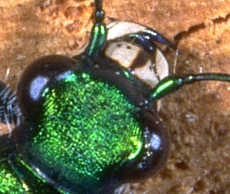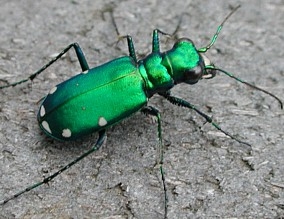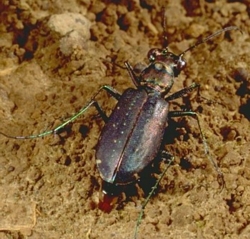|
|
ARTHROPODS:
Insects»
Spiders»
Centipedes»
Millipedes»
Sowbugs»
Harvestmen»
Mites
& Ticks»
Scorpions»
Identification
Tips»
About
the Critter Files»
Links» |
|
|
|
 |
TIGER
BEETLES
Critter
Files/Insects/Beetles/Tiger
Beetles
By Blake Newton
University of Kentucky Department of Entomology |
| |
|
| Common
Kentucky Tiger Beetles: |
| |
| TAXONOMY |
KINGDOM:
Animalia | PHYLUM: Arthropoda | CLASS: Insecta | ORDER:Coleoptera
| FAMILY:Cicindelidae (tiger beetles) |
| |
| Other
Names: Cincindelids |
| |
WHAT
IS A TIGER BEETLE?
LIFE CYCLE
ECOLOGY
PEST STATUS
COMMON KENTUCKY TIGER BEETLES
COLLECTING & PHOTOGRAPHY
TIGER BEETLE FACTS
MYTHS, LEGENDS, AND FOLKLORE |
| |
| WHAT
IS A TIGER BEETLE? |
|
Like all
beetles, Tiger Beetles have chewing mouthparts
and hardened front wings (elytra) that meet in a straight line down
the back of the abdomen when closed. Tiger beetles closely
resemble their relatives the Ground
Beetles (Carabidae), but can be distinguished by their overlapping
sickle-shaped jaws. Most Kentucky species are shiny, metallic
blue, green, copper, or orange.

Tiger
Beetle, showing overlapping mandibles (R. Bessin, 2001)
|
|
| SIZE:
Adult body length up to 3/4" |
| |
| LIFE
CYCLE |
|
Like
all beetles, tiger beetles have "complete" metamorphosis
with egg, larval, pupal, and adult stages. Female tiger beetles
place eggs into small holes dug into soil. Upon hatching,
larvae find dry soil and constuct vertical tubes where they will
later pupate. Adults emerge from the tubes in summer.
The Tiger Beetle World homepage has pictures of tiger beetle larvae and more information about the tiger beetle life cycle.
|
| ECOLOGY |
|
| |
Tiger beetles
are predators that feed on small insects, spiders, and other athropods.
They are fast, agile flyers, and are able to catch insects in the
air.
Tiger beetle larvae are
also predators, and have a lifestyle very similar to antlion larvae.
Tiger beetles live in vertical tunnels in sandy soil where they
wait for ants, spiders, other other small creatures. When prey gets
close enough, the larva pops out and grabs it.
The Univeristy of Florida's
Department of Entomology has more information about tiger beetle
biology at their "Featured Creatures" website:
http://creatures.ifas.ufl.edu/misc/tiger/tbeetle3.htm
|
| |
| PEST
STATUS |
|
Tiger beetles
are not considered pests. |
| |
| |
| COMMON
KENTUCKY TIGER BEETLES |
|
|
SIX-SPOTTED
TIGER BEETLE
GENUS and SPECIES:
Cicindela sexguttata
The Six-Spotted
Tiger Beetle (Cicindela sexguttata), below, is
bright metallic green with white spots. It is very common
along forest paths in Eastern Kentucky, and is one of the most commonly
seen tiger beetles in the state. |
| |
 Six-Spotted
Tiger Beetle (B. Newton, 2002) Six-Spotted
Tiger Beetle (B. Newton, 2002) |
|
|
|
OTHER
CICINDELA spp.
GENUS:
Cicindela
In
addition to Cicindela sexguttata, shown above, there are
several other tiger beetles in the genus Cincindela that
live in Kentucky. Like the Six-Spotted Tiger Beetle,they are common in forests. |
| |
 Cicindela
sp. (R. Bessin, 2000)
Cicindela
sp. (R. Bessin, 2000) |
|
| |
| COLLECTING
& PHOTOGRAPHY |
|
Tiger beetles are one
of the most difficult kinds of insects to capture. On warm
summer days, you can find them commonly along forest paths, but
they are fast flyers and will bolt away if a human approaches within
a few feet. An aerial net, along with considerable patience,
is required to catch tiger beetles. Beware: tiger beetles
can pinch you with their large mandibles.
Getting a good photograph
of a tiger beetle can be even more difficult. For best results,
try sneaking up on them very slowly. The beetle may fly away,
but it will usually land just a few feet further up the trail, and
it will do this repeatedly. If you are careful enough, you
will eventually get close enough for a picture.
Tiger beetle larvae are
often found in loose, sandy soil in the same areas that the adults
inhabit. The larvae are easy to capture (if you can find their
burrows), but, like the adults, they can bite. Tiger beetle
larvae should be preserved in alcohol.
|
| |
| TIGER
BEETLE FACTS |
|
Tiger beetles are very
closely related to ground beetles (family Carabidae), and most of
the beetles in both of these groups are predators both as larvae
and adults.
There are a few tiger
beetle species that are threatened or endangered. This page
from the Connecticut Dept. of Environmental Protection discusses
the Puritan Tiger Beetle, an endangered species.
Because of their bright,
striking color patterns, tiger beetles are very popular insects.
Below are some other websites devoted to tiger beetles.
Dr. Jay's Tiger Beetle
Page:
http://members.aol.com/askdrjay/cicindla.htm
Tiger Beetles of Connecticut:
http://collections2.eeb.uconn.edu/collections/insects/CTBnew/ctb.htm |
| |
| MYTHS
- LEGENDS - FOLKLORE |
|
Have you heard any
myths, legends, or folklore about tiger beetles? If so, let
us know. |
| |
Original document: 25 May 2004
Last updated: 25 May 2004
Photos courtesy R. Bessin and B. Newton, University of Kentucky
The Kentucky Critter
Files are maintained by Blake Newton, Department of Entomology, University
of Kentucky.
Contact: blaken@uky.edu |
|

